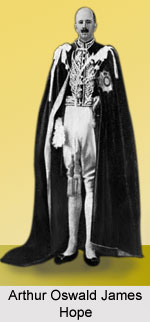 Arthur Oswald James Hope, formally addressed as Arthur Oswald James Hope, 2nd Baron Rankeillour GCIE MC, was as one of the Governors of Madras Presidency from the year 1940 to 1946, in the former undivided India under the rule of the British Empire. He was a well known British politician. Hope also served as a British soldier and a colonial administrator. Arthur Oswald James Hope served as Member of Parliament for Nuneaton from the year 1924 to 1929. Later he served as Member of Parliament for Birmingham Aston from 1931 to 1939. He was also appointed as the Governor of Colonial Madras under British India in the year 1940.
Arthur Oswald James Hope, formally addressed as Arthur Oswald James Hope, 2nd Baron Rankeillour GCIE MC, was as one of the Governors of Madras Presidency from the year 1940 to 1946, in the former undivided India under the rule of the British Empire. He was a well known British politician. Hope also served as a British soldier and a colonial administrator. Arthur Oswald James Hope served as Member of Parliament for Nuneaton from the year 1924 to 1929. Later he served as Member of Parliament for Birmingham Aston from 1931 to 1939. He was also appointed as the Governor of Colonial Madras under British India in the year 1940.
Early Life of Arthur Oswald James Hope
Arthur Oswald James Hope was born on 7 May 1897 in Marylebone in London, England, to the parents James Fitzalan Hope, 1st Baron Rankeillour, and Mabel Ellen Riddell. Hope had 3 other siblings, namely Richard Frederick Hope, Joan Mary Hope and Henry John Hope, 3rd Baron Rankeillour. His father served as a Deputy Speaker of the House of Commons. Arthur Oswald James Hope studied at The Oratory School and later at Sandhurst.
Career of Arthur Oswald James Hope
In the year 1914, he joined the Coldstream Guards during the commencement of World War I and was promoted to the ranks of Captain. During the First World War, Hope served with distinction in France and was mentioned in dispatches. He was also honoured with the Military Cross and the Croix de Guerre. He soon entered public life after his military service was concluded.
Later Arthur Oswald James Hope, 2nd Baron Rankeillour GCIE MC joined the Conservative Party. He was elected to the Parliament of the United Kingdom from the Nuneaton constituency in Warwickshire at the 1924 general election. On 12 March 1940, Hope was appointed Governor of Madras Presidency in British India. He was preceded by Sir John Francis Ashley Erskine. The Madras Presidency, also known as the Presidency of Fort St. George and Madras Province, was an administrative sub division of British dominated India. The territory included most of southern India, such as the modern states of Tamil Nadu, the Coastal Andhra and Rayalaseema regions of Andhra Pradesh, Lakshadweep Islands, the Malabar region of North Kerala, Koraput, Malkangiri, Nabarangapur and Gajapati districts of southern Orissa and the Bellary, Ganjam, Dakshina Kannada, Rayagada and Udupi districts of Karnataka.
Arthur Oswald James Hope became the Governor of Madras during the Second World War. The province was in a state of emergency when he the last elected government resigned in October 1939. The Quit India Movement began in the year 1942 under the leadership of Mahatma Gandhi. Moreover an anti- British campaign was also launched. Arthur Hope enforced censorship of newspapers in Madras Presidency and reporting on internal politics was also monitored. The British administration also imposed censorship on Indian language films. An order under the Defence of India Act was issued in 1943 by the Colonial government that restricted the size of native films to 11,000 feet.
The various battalions of the Madras Regiment were disbanded in stages due to economic reasons and later ceased to exist. Hope tried to revive the Madras Regiment and the Madras Regiment was revived in the year 1942. He was appointed as the first Colonel-in-chief of the regiment.
Arthur Oswald James Hope, 2nd Baron Rankeillour GCIE MC, retired from the position of Governor of Madras on 26 February 1946. He was succeeded by Sir Henry Foley Knight who served as the Acting Governor. Hope inaugurated a polytechnic college (Arthur Hope Polytechnic) in Coimbatore in 1945. The institute was later renamed Government College of Science and Technology in 1950.
Personal Life of Arthur Oswald James Hope
Arthur Oswald James Hope was married with Grizel Gilmour on 2 June 1919. She was the 2nd daughter of Brigadier General Sir Robert Gordon Gilmour. The couple had had 4 daughters namely Bridget Mary Hope, Jean Margaret Hope, Alison Mary Hope and Barbara Mary Hope. He died on 26 May 1958 at the age of 61 in Surrey, England. the barony passed on to Henry John Hope, his brother, due to the absence of a male heir.
Honours of Arthur Oswald James Hope
Arthur Oswald James Hope was knighted with Knight Grand Commander of the Most Eminent Order of the Indian Empire (GCIE) in the year 1939, prior to his appointment as Governor of Madras Presidency. Hope succeeded to the barony on the death of his father, the 1st Baron on 14 February 1949. He was also awarded a Military Cross (MC).



















